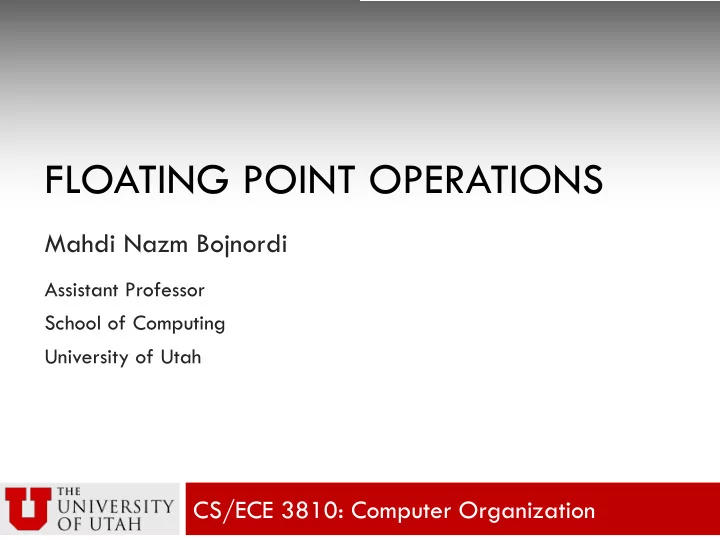

FLOATING POINT OPERATIONS Mahdi Nazm Bojnordi Assistant Professor School of Computing University of Utah CS/ECE 3810: Computer Organization
Overview ¨ Notes ¤ Homework 6 will be posted tonight n Deadline: Mar. 5 th ¨ This lecture ¤ Floating point operations ¤ Basics of logic design
Recall: Floating Point Addition ¨ Numbers maintain only 4 decimal digits and 2 exponent digits n 9.999 x 10 1 + 1.610 x 10 -1 ¤ Convert to the larger exponent n 9.999 x 10 1 + 0.016 x 10 1 ¤ Add n 10.015 x 10 1 ¤ Normalize n 1.0015 x 10 2 ¤ Check for overflow/underflow ¤ Round n 1.002 x 10 2 ¤ Re-normalize
Recall: Floating Point Addition ¨ Numbers maintain only 4 decimal digits and 2 exponent digits n 9.999 x 10 1 + 1.610 x 10 -1 ¤ Convert to the larger exponent n 9.999 x 10 1 + 0.016 x 10 1 ¤ Add n 10.015 x 10 1 ¤ Normalize n 1.0015 x 10 2 If we had more fraction bits, ¤ Check for overflow/underflow these errors would be minimized ¤ Round n 1.002 x 10 2 ¤ Re-normalize
Floating Point Addition ¨ Numbers maintain only 4 binary digits and 2 exponent digits n 1.010 x 2 1 + 1.100 x 2 3 ¤ Convert to the larger exponent n 0.0101 x 2 3 + 1.100 x 2 3 ¤ Add n 1.1101 x 2 3 ¤ Normalize n 1.1101 x 2 3 ¤ Check for overflow/underflow
Floating Point Addition ¨ Numbers maintain only 4 binary digits and 2 exponent digits n 1.010 x 2 1 + 1.100 x 2 3 ¤ Convert to the larger exponent n 0.0101 x 2 3 + 1.100 x 2 3 ¤ Add n 1.1101 x 2 3 ¤ Normalize n 1.1101 x 2 3 ¤ Check for overflow/underflow ¤ IEEE 754 format (32-bit) 0 10000010 11010000000000000000000
Floating Point Addition ¨ Example: add the following two single-precision floating point numbers. A: B: Steps: 1. Convert to larger exponent 2. Add 3. Normalize 4. Round
Floating Point Addition ¨ Example: add the following two single-precision floating point numbers. A: B: E A = 128 M A = 1.11 two E B = 131 M B = 1.010011 two E A = 131 M A = 0.00111 two E B = 131 M B = 1.010011 two E A = E B = 131 M A + M B = 0.00111 two + 1.010011 two = 1.100001 two A + B:
Floating Point Multiplication ¨ Similar steps are required for multiplication ¤ Compute exponent n Need to remove bias ¤ Multiply significands n May end up unnormalized ¤ Normalize n Shift the point ¤ Round n Fit in the number of bits ¤ Assign sign n Compute sign
Floating Point Multiplication ¨ Example: multiply the following two single-precision floating point numbers. A: B: Steps: 1. Compute exponent 2. Multiply significands 3. Normalize 4. Round 5. Compute sign
Floating Point Multiplication ¨ Example: multiply the following two single-precision floating point numbers. A: B: E A = 128 M A = 1.11 two E B = 131 M B = 1.010011 two E AxB = 128 + 131 – 127 = 132 M AxB = 10.01000101 two E AxB = 133 M AxB = 1.001000101 two A x B:
Floating Point Instructions ¨ MIPS employs separate registers for floating point ¤ 32-bit registers: $f0, $f1, …, $f31. ¤ Each register represents a single-precision number ¤ Register pairs are used for double-precision n Example: $f0 refers to {$f0, $f1}
Floating Point Instructions ¨ Load/Store instructions by coprocessor 1 (c1) ¤ Still use integer registers for address computation ¨ Comparison instructions ¤ Set an internal bit (cond) to be inspected by branch instructions
Code Example ¨ Convert a temperature in Fahrenheit to Celsius float f2c(float fahr) { return ((5.0/9.0)*(fahr–32.0)); } ¤ Assume that constants are stored in global memory
Code Example ¨ Convert a temperature in Fahrenheit to Celsius float f2c(float fahr) { return ((5.0/9.0)*(fahr–32.0)); } ¤ Assume that constants are stored in global memory $gp const9 Memory: const5
Code Example ¨ Convert a temperature in Fahrenheit to Celsius float f2c(float fahr) { return ((5.0/9.0)*(fahr–32.0)); } ¤ Assume that constants are stored in global memory f2c: mtc1 $a0, $f12 lwc1 $f16, const5($gp) lwc1 $f18, const9($gp) $gp div.s $f16, $f16, $f18 const9 lwc1 $f18, const32($gp) Memory: sub.s $f18, $f12, $f18 mul.s $f0, $f16, $f18 jr $ra const5
Recommend
More recommend